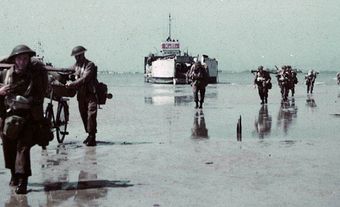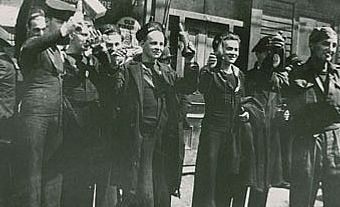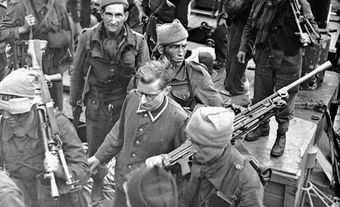The Battle of the Scheldt was fought in northern Belgium and southwestern Netherlands in 1944 during the Second World War. It was part of the Allied campaign to liberate northwestern Europe and defeat Nazi Germany. The First Canadian Army played a crucial role in clearing the Scheldt of German forces, opening crucial supply lines via the port of Antwerp. However, this victory came at a cost. The Allies suffered nearly 13,000 casualties during the battle, including more than 6,300 Canadians.

Map of the Battle of the Scheldt (1 October–8 November 1944) during the Second World War. The First Canadian Army successfully cleared the Scheldt of German occupiers, clearing critical supply lines for the Allies.
(CP Stacey, Official History of the Canadian Army in the Second World War, Volume III: The Victory Campaign — The Operations in North-West Europe, 1944–1945 (1960), p. 424)
Battle of the Scheldt: Key Facts
| Date
|
1 October–8 November 1944
|
| Location
|
Northern Belgium, Southwestern Netherlands
|
| Participants
|
Allies: Canada, United Kingdom, Poland, United States, Belgium, Netherlands Axis: Germany |
| Casualties
|
Allies: 12,873 killed, wounded or missing (6,367 Canadians) Germany: 41,043 prisoners taken by Allied forces (casualties unknown) |
Background
On 6 June 1944, nearly 150,000 Allied troops landed on the beaches of Normandy (see D-Day and the Battle of Normandy). This included the First Canadian Army, an international force led by Canadian General Henry Duncan Graham (Harry) Crerar. Over the next few months, they fought their way through France, into Belgium and toward the Netherlands. (See Liberation of the Netherlands.)
By September 1944, the First Canadian Army had cleared much of the French coast, while the Second British Army had reached the southern Netherlands. However, the Allied advance stalled that month when British, American and Polish troops failed to seize a bridge over the Rhine River at Arnhem. Operation Market Garden resulted in 1,400 Allied deaths and the capture of another 6,000 by German forces.
Importantly, though, the Second British Army had liberated the Belgian port of Antwerp on September 3. This was crucial for the Allies, who faced a difficult winter campaign with supply lines stretching back to Normandy. Before they could land supplies at Antwerp, however, they had to clear the area of German forces. Antwerp, the second largest port in northwestern Europe, was located about 80 km inland and was connected to the sea by the Scheldt River. The mouth of the river and estuary were controlled by German troops, who would have to be removed before the port could be opened. The First Canadian Army was given the task of clearing the area.

Sergeant Hugh H. McCaughey of the Canadian Army Film and Photo Unit filming the advance of The North Shore Regiment across the Scheldt River from the Ayelsche Gat to Eecloo, Belgium, 11 October 1944.
(photo by Lieut. Donald I. Grant, courtesy Canada. Dept. of National Defence / Library and Archives Canada / PA-137227)
Battle of the Scheldt
During the Battle of the Scheldt, the First Canadian Army was commanded by Lieutenant General Guy Simonds. (General Crerar had returned to England because of illness.) Simonds and his men faced a daunting challenge. The terrain was flat, muddy and flooded, much of it below sea level. The region was characterized by polders (low-lying fields that had been drained and reclaimed from the sea for agricultural use) and bordered by a series of canals and dykes around four to five metres in height. Armoured vehicles became stuck in the mud, and the attackers had to travel along exposed, narrow roads built along the tops of the dykes. In these conditions, defenders had a clear advantage. Moreover, the Germans had established strong defences, including heavy artillery.
We went across there, a thousand yards, with no cover, no nothing. The only thing that was there was beets. How the hell we ever got across, I don’t know, because the Germans were dug into a big dike at the other side, which contained the railway and a roadway, the only way to get to Walcheren [Island].(William “Bill” Davis, The Memory Project)
Operations began in early October. The fighting was ferocious, and the First Canadian Army suffered heavy casualties. On October 13th, for example, the Black Watch regiment lost 145 men and all its commanding officers on what became known as “Black Friday.”
On October 16, British Field Marshal Bernard Montgomery ordered that clearing the Scheldt would be the main priority of the forces under his command. The 52nd British Division was therefore attached to the First Canadian Army. Although German resistance was fierce, the Allies secured much of the area by November 3. By this point, exhausted Canadian units had been pulled back from the battlefront and replaced by British units.

Buffalo amphibious vehicles carrying troops across the Scheldt River to Hooftplaat during the Second World War (13 October 1944).
(photo by Donald I. Grant, courtesy Canada. Dept. of National Defence / Library and Archives Canada / PA-136754)
Only Walcheren Island at the mouth of the Scheldt remained in German hands. The island had been heavily fortified and was difficult to attack. The only land approach was a long, narrow causeway. The lands surrounding it were too wet to cross by foot, but the water was too shallow to cross by boat. The Royal Air Force therefore bombed the dykes, flooding the area and allowing an amphibious assault. The Allies launched a three-pronged attack and finally secured the island's capital, Middelburg, on November 6. German resistance ended on November 8.
Did you know?
British Field Marshal Bernard Montgomery nicknamed the 3rd Canadian Division the “Water Rats” because of their experience in amphibious operations in Normandy and during the Battle of the Scheldt. This was a play on “Desert Rats,” the nickname given to the 7th Armoured Division, part of the British Eighth Army that had fought under Montgomery in North Africa.

Locals watch as Royal Navy vessels clear the Scheldt River, opening up the port of Antwerp for Allied use during the Second World War (October 1944).
(photo courtesy of Canada. Dept. of National Defence / Library and Archives Canada / e002113670)
Significance
By late November 1944, all mines had been cleared from the Scheldt river. On November 28, the first Allied convoy entered the port of Antwerp. The port was crucial to the Allies as they continued their European campaign. By the end of April, the Netherlands had been liberated, and on 5 May 1945, German forces in the country officially surrendered. The war in Europe ended two days later. (See Canadian Soldiers and the Liberation of the Netherlands and V-E Day.)
The Battle of the Scheldt played an important role in Allied victory in the Second World War. They had secured the Scheldt, opening the port of Antwerp and capturing 41,043 German soldiers in the process. But they also suffered heavy casualties: 12,873 killed, wounded or missing — including 6,367 Canadians.
The dirtiest job the Canadian army had was to open up the Scheldt because the Allies desperately needed the port of Antwerp. ... So the 3rd Division was given the job of clearing the west side and we [2nd Canadian Infantry Division] were given the job of clearing the east side, which was the Beveland Peninsula and the Island of Walcheren. And that was the dirtiest job that we ever had [Battle of the Scheldt]. And at that time, we were taking casualties so heavy, the army broke up anti-aircraft units and signal units and sent those guys into action as infantry men. The poor devils never had a hope in hell of making it home. It was really horrible. (William “Bill” Davis, The Memory Project)

A woman places flowers on graves in October 1944, likely in the Netherlands. In October and early November 1944, Allied forces fought a fierce battle to clear the area around the Scheldt River. Victory came at a heavy cost. The Allies suffered nearly
13,000 casualties during the battle, including more than 6,300 Canadians.
(photo courtesy of Canada: Dept. of National Defence / Library and Archives Canada / e002113671)
Remembrance
Most of the Canadians who died during the Battle of the Scheldt are buried at the Adegem Canadian War Cemeteryin Oost-Vlaanderen province, Belgium, or the Bergen-op-Zoom Canadian War Cemetery in Noord-Brabant, Netherlands.

Bombardier C. A. Flanders writing a letter from the deck of his houseboat on the Scheldt River, which is home for some of the gun crew, 2 October 1944.
(photo by Lieut. Ken Bell, courtesy Canada. Dept. of National Defence/Library and Archives Canada/PA-145574)

 Share on Facebook
Share on Facebook Share on X
Share on X Share by Email
Share by Email Share on Google Classroom
Share on Google Classroom





